Altering your Melodic Minor consciousness
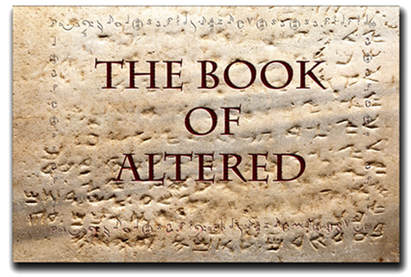
So - as the late great Eddie Harris once said - "Listen Here"!
Since we'd all probably agree that the so called "Altered Scale" (aka "Altered Dominant Scale", "Diminished / Whole Tone Scale", "Pomeroy Scale", and Locrian b4, et al) is derived from the Seventh Mode of Melodic Minor - which is itself derived from the Major Scale matrix - we've pretty much answered our own question.
Simple enough.
When you try to locate Paris on a map, you'd probably first try to locate France, right?
The point here is, the simplest way to find and the most effective way to master and utilize the "Altered Scale" is to think of it in terms of the Melodic Minor scale/ key of which it is a part (i.e. seventh mode of).
For example, as its seventh mode, B altered is part of - and contains all the same notes as - C Melodic Minor.
B-C-D-Eb-F-G-A-B = B Altered
C-D-Eb-F-G-A-B-C = C Melodic Minor
Automatically and instinctively thinking "C Melodic Minor" when you see B7 or B7alt will open up your tonal palette. Knowing this relationship in all 12 Melodic Minor keys will open the door to the next realm of inside / outside tension and release.
Much Melodic Minor material and explanations have been posted on this blog, but I'll reiterate a few basic, albeit important points here.
- The simplest way to form a Melodic Minor scale is by taking the Major Scale with the same letter name, and flatting its 3rd degree (C Maj = C-D-E-F-G-A-B, and becomes C-D-Eb-F-G-A-B = C Mel Min.). Flatting the 3rd disrupts the continuous flow of Perfect 5ths (F-C-G-D-A-E-B) which comprise the Major Scale matrix, and creates a scale with not one - but two tritones (F-B & Eb-A).
- The Altered Scale (Seventh Mode) is a dominant functioning mode, containing root - Maj 3rd & b7, plus alterations of the four upper structure intervals - b9, #9, #11(b5) & b13.
- Melodic Minor (which, as you now know, includes the Altered Scale) contains no so called "avoid notes". The prime example of an "avoid note" would an F held against a C Maj 7, as it creates a tritone with the note B, the 7th of C Maj7, and clashes with the Major sound and function. The Melodic Minor / Altered Scale has no such restrictions, providing a sense of freedom of note choice for the user.
"The Book of Altered" is an expansion of a few of the concepts first published in "The Melodic Minor Handbook (Aebersold)", in 2005. The focus of this new Shortbook™ is on minor ii-V7-i sequences, which employ the "ACE" 3 Melodic Minor scale / key method, as well as bVI7-V7-i and i-bVI-V7-i sequences.
The acronym "ACE" refers to the letter names of the three Melodic Minor scale / keys which make up this type of minor ii-V7-i cadence, in the overall tonic key of E minor, in this case. This is the only tonic minor key in which the letter names actually spell a recognizable word, as Bb-Db-F, or F#-A-C# might be difficult to pronounce. They all do, however, spell out the letter names of minor triads, the final letter of which reveals the tonic minor key of that particular ii-V7-i.
As an example:
ii = F#-7b5 = A Melodic Minor
V7 = B7alt = C Melodic Minor
i = E min = E Melodic Minor
Here's another one, as in Ex.1 below:
ii = D-7b5 = F Melodic Minor
V7 = G7alt = Ab Melodic Minor
i = C min = C Melodic Minor
Again A-C-E and F-Ab-C are also the letter names of minor triads, which can be used as a shortcut in determining which Melodic Minors are relevant for each chord. In each case the "5th" of the triad represents the tonic key of the ii-V7-i in question'
Say we want to figure out which three Melodic Minor scale / keys to use with a ii-V7-i in G min (A-7b5 / D7alt / G min).
G is the 5th of a C min triad (C-Eb-G), so
ii = A-7b5 = C Melodic Minor
V7 = D7alt = Eb Melodic Minor
i = G min = G Melodic Minor
"The Book of Altered" also explores Melodic Minor usage with the bVI7-V7-i cadence (Ex. 3 thru 5), which is most commonly found in the last four bars of a "Mr. PC" type of Minor Blues. In Melodic Minor terms - in the tonic key of C Minor, that translates to:
bVI7 = Ab7#11 = Eb Melodic Minor
V7 = G7alt = Ab Melodic Minor
i = C min = C Melodic Minor
Note names Eb-Ab-C also spell out a second inversion Ab Maj triad. That's your bVI7-V7-i “ACE” shortcut. Try a few other ones on your own.
The bVI7, interestingly enough, functions in place of the ii7b5 (D-7b5) and acts as a tritone substitution for the secondary dominant (II7#11.= D7#11) with the other altered extensions included.
ii = D-7b5 = F Melodic Minor = F -G -Ab-Bb-C-D-E
bVI7 = Ab7#11 = Eb Melodic Minor = F-Gb-Ab-Bb-C-D-Eb
Eb Melodic Minor contains all the notes of the original ii7b5 chord (D-7b5 = D-F-Ab-C)).
The example below illustrates and accents the note "F", which is one of the two common tones to all 3 Melodic Minor scales / keys (F, Ab & C Melodic Minor) in this ii-V7-i. The other common tone is G.....
.....and gee whiz, G it is.
This example illustrates the use of triad pairs in a bVI7-V7-i line, which resolve smoothly into each succeeding measure and MM scale / key.
Melodic Minor triad pairs, in this book and elsewhere, are the augmented triad built on the 3rd scale degree coupled with the Major Triad built on that scale's 4th degree.
bVI7 = Ab7#11 = Eb Melodic Minor = Ab Maj & Gb+ Triads
V7 = G7alt = Ab Melodic Minor = Db Maj & B+ Triads
i = C min = C Melodic Minor = F Maj & Eb+ Triads
The next example below employs a slight tweak in the triads from the previous example.
bVI7 = Ab7#11 = Eb Melodic Minor = Eb min & Gb+ Triads
V7 = G7alt = Ab Melodic Minor = Db Maj & B+ Triads
i = C min = C Melodic Minor = C min & Eb+ Triads
F Maj & Eb Maj (no 5th)
And last, but not least, a i-bVI7-V7-i sequence, which employs a scalar gliss from a descending bottom note, to a common top note in the first two bars. The bVI7-V7 in measure #2 is 2 beats per chord. The thing that stands out most to me about the bVI7 is that it supplies the b5 of the tonic key (in this case Gb), and its all important "blues connotation".





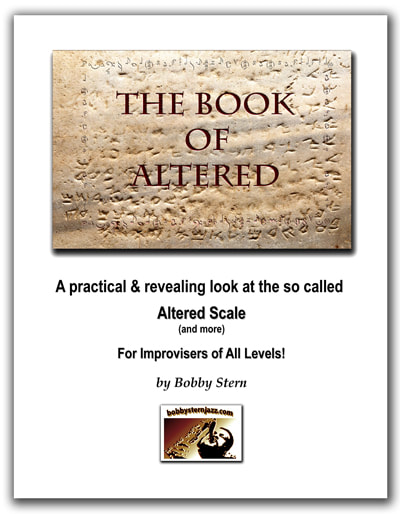

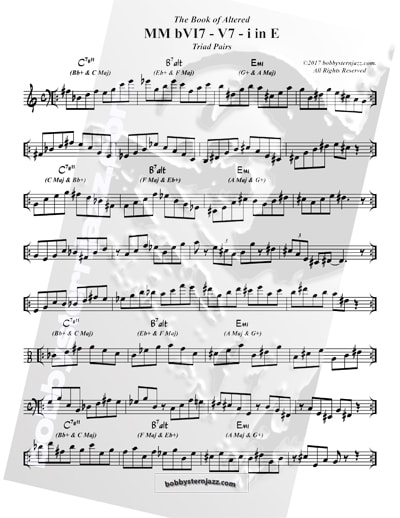
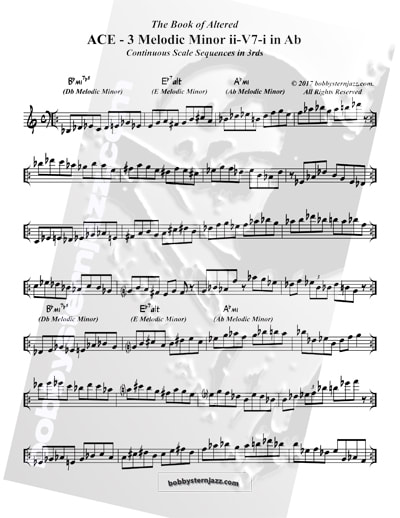
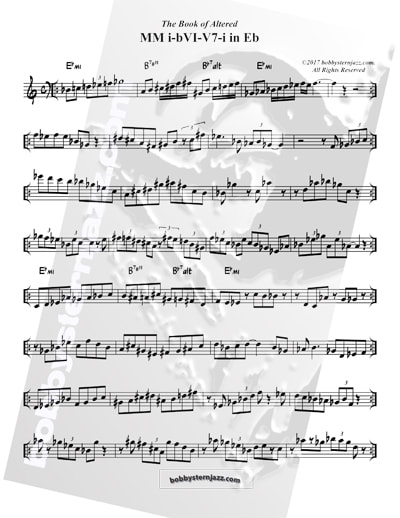

 RSS Feed
RSS Feed









